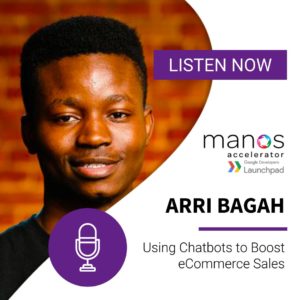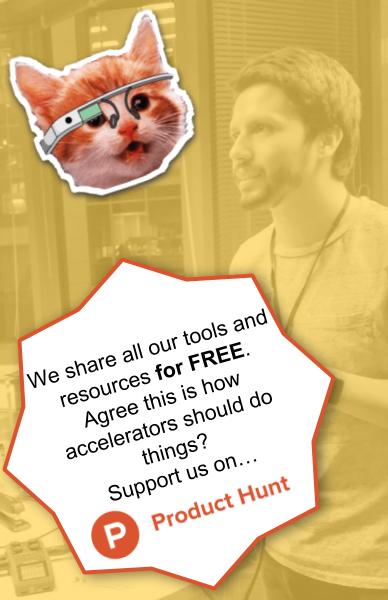 Arri Bagah is the founder & CEO of ROAS. ROAS helps e-commerce brands generate sales and increase brand affinity using chatbots, voice, and AR. Arri has helped Google, HubSpot, and Facebook to build smarter chatbot solutions by providing his expertise through consulting.
Arri Bagah is the founder & CEO of ROAS. ROAS helps e-commerce brands generate sales and increase brand affinity using chatbots, voice, and AR. Arri has helped Google, HubSpot, and Facebook to build smarter chatbot solutions by providing his expertise through consulting.
He is a contributor at Chatbot Magazine and recently founded, The Chatbot Channel a Facebook community for e-commerce marketers to not only learn about how to best leverage chatbots, voice and AR but to also share their insights with other top-level e-commerce marketers. He moved to the United States when he was 12 years old, is a college dropout turned entrepreneur, and is a US army reserve member.
SUBSCRIBE
Show Notes
You are listening to the Manos Accelerator podcast in partnership with Google Launchpad. We interview rockstar entrepreneurs who share their exact formulas for success in customer acquisition, growth hacking, fundraising or scaling a company, and I’m your host, Juan Felipe Campos. Okay, Manos Nation! Remember, for every episode there’s a giveaway of digital goods or resources from our partners that other people would normally pay for. To enter the giveaway, subscribe to the podcast on iTunes now and then message the word “Manos” to m.me/ManosAccelerator. Again, that’s Manos to the website, m.me/ManosAccelerator. To prove it
Juan: 00:59 Today, I am with Arri Bagah you’re working on chatbots for my media clients, so Arri you’re one of the best people in your industry when it comes to chatbots using chatbots for eCommerce, leveraging them for small businesses. Can you tell us a little bit about your career like related to chatbots, to give us some context about what you’ve worked on?
Arri: 01:14 Yes, so before I made chatbots for our clients. I was working on Facebook advertising and because Facebook ads have been so saturated and they’ve gotten so expensive, I was looking for new channels to use to help our eCommerce clients generate more revenue or increased engagement and create a larger community for their customers. So when I found out about chatbots and how cheap they were, I knew this was the perfect opportunity. So last year when they got released to the public, uh, I hopped on the bandwagon and started building chatbots for our eCommerce clients for small businesses and all those types of businesses and doing that, uh, I found many new strategies, uh, that small businesses and eCommerce businesses can use to not only increase revenue but also create that loyal fan base so that people keep coming back to buy. So yeah,
Juan: 02:14 It’s, it’s, it’s pretty new tech. Can you fill us in a little bit about like, what a chatbot is, how it’s used? Yeah.
Arri: 02:23 Yeah, that’s a great question because like, usually when you talk about chatbots, like nobody knows what it is. Uh, I even met a media buyer. He did not. Who did not know what a chatbot was, so a good question. A chatbot is basically a software that allows businesses to communicate with their current customers or potential customers in messaging apps. So you can build chatbots in Slack, Messenger, uh, all these apps, but what we focus on right now is Facebook Messenger because their user base is so huge and Facebook Messenger actually has more active users than the Facebook app itself every single month. So we’re talking about over 2 billion monthly active users. So that’s why we’re focusing on Facebook Messenger because everyone’s ideal customer is on Messenger right now.
Juan: 03:10 And it is new tech, but you’ve already seen amazing results, right? You were telling me about some Kickstarter campaigns thing, some Kickstarter campaigns that you brand. And so tell us a little bit about those success metrics that you’ve seen some really great results here.
Arri: 03:24 Yeah, so for some of our clients use chatbots to increase engagement, uh, engage with potential customers and must be engaged with them. You want to build that relationship. So for a Kickstarter, obviously the product is not out yet. So that requires a lot of nurturing for potential customers to become backers. So for a client, what we did is at the top of the funnel, when we acquire those subscribers, we try to put them through a sequence that teaches them more about the product and then have a call to action at the end. Um, in terms of growth strategies, what we did was a, having a regular website slide in. So a lot of people ask about how you can get people to subscribe to your chatbots or different ways you can do it.
Arri: 04:15 You can use website widgets like popups, website slide ins, the, uh, the header bars, or you can have people subscribe to Facebook ads. So in this case, we use a website slide in uh, doing a giveaway campaign for the product that’s coming out. So we’re driving lots of traffic through Facebook ads to this landing page. And we just had the landing page was collecting email addresses, but we also had a website slide in uh, a Messenger opt-in that was collecting uh Messenger subscribers. So that usually when you have popups on a landing page, the average conversion rate is about three percent, uh, but this add in was converting at 17 percent and we collected thousands of Messenger subscribers to put them through that sequence to nurture them to make sure that they’re ready to a pledge for this product when it comes to Kickstarter launches.
Arri: 05:06 Um, but one thing to add to that, one thing I wanted to do, a one thing I like to do is combine Facebook Messenger and email marketing because you want to cover both channels because some people might not open your, uh, your email, but you want to also hit them up on Messenger. So once they get subscribed, there’s something called Messenger forms where you can collect user information. So when a user gets subscribed on Messenger, you do not get their email address or their phone number, so you have to ask them. So, uh, I say something like, would you like to join our wait list? And we collected an extra, uh, like we collected email addresses of 50 percent of people who get subscribed through Facebook Messenger. So that’s like before we’re driving traffic and we had like a $1 cost per lead and we were collecting leads on a landing page, capturing Messenger subscribers and capturing emails inside Messenger. So that was like three conversions for $1 and yeah, it was one of the greatest campaigns that we ran.
Juan: 06:12 So if I’m running an ecommerce business or like any kind of small business online, you’re saying like, why are you putting so much effort towards just getting people to your website and you get them there and you get them there once. So like what everybody’s doing. It’s like, oh well I’ll just retarget them with the Facebook Pixel. What you saying is you can get like so many different touch points from that one website visit and you’re missing out on a lot of nurturing, like what you’re calling nurturing, which is basically sending them more benefits, sending them white papers, sending them value. Just staying top of mind from that one website visit so that somebody that visited you two months ago, two months later, still knows about your brand, still remembers you really well because they’ve seen your videos that you’re sending them through email or through Facebook Messenger and you’re using these slides ins actually get people to opt into the Messenger and then you’re just still staying top of mind with those people so that every website visit becomes that much more valuable than just someone that went there and then they forget about you.
Arri: 07:08 Right? Right. And also like one great thing about this campaign is that the only reason why you collect somebody’s email address is to reach out to them. Right? So, and usually what we found, if email is that your open rates goes down because people do not open their emails. Uh, so people usually average around 20, 30 percent. Um, but in Facebook Messenger we have thousands of subscribers and our average open rate was like 95 percent. So once we launched that Kickstarter campaign, I’m like pretty much everyone that you wanted to see the campaign, uh, that to see that the campaign launch saw that the campaign did launch and the click through rate was I think 65 percent, uh, which is, which is crazy. Like you never see that anywhere else. So yeah, uh, the Messenger definitely did work great for this slide.
Juan: 08:03 And the thought process there, what probably gets you really excited about this technology is that we kind of all have email fatigue. We’ve, we use our email for everything. So our email inbox, even like Gmail has it split up into like the promotions and updates and like all of these different tabs because there’s just so much information coming in. So we’ll ignore 100 emails before we actually look at like a promotional or a launch of something like that. It’s so easy for that to just slip past. Whereas Messenger, most people have like 300 friends or 500 friends. So if you get a message or notification you’re going to read it. That’s for like most people, it’s like 99 percent of people are like, you just can’t see that little red notification icon and not click on it and see like what, who messaged me, you’re saying this is the best technology for that because you don’t even have to go person by person. You can just blast out messages. Hey we, we launched on Kickstarter and the people that actually would back you back. You now they don’t have the excuse of, oh I just had no idea that you guys launched. I completely forgot about it. I didn’t see your email. They’re going to see it and they’re gonna be able to act on it.
”It’s very important to do a giveaway campaign to get as many subscribers as possible. So another tactic that you can do is to create a viral effect inside the chatbox. So once you get somebody subscribed, you can say thank you for subscribing, you have been entered for the giveaway and you can give them an option to actually share the giveaway campaign.
Arri BagahFounder of ROAS
Arri: 09:02 Right. Correct. So.
Juan: 09:06 That’s amazing. Do you have a really tactical, um, you know, like tip that we can walk away from if like, like we understand the whole thought process, how do we actually get the subscribers to get the open rates, get the click throughs?
Arri: 09:20 Yeah, so obviously you have the website slid in and it’s very important to do a giveaway campaign to get as many subscribers as possible. So another tactic that you can do is to create a viral effect inside the chatbox. So once you get somebody subscribed a, you can say thank you for subscribing, you have been entered for the giveaway and you can give them an option to actually share the giveaway campaign.
Arri: 09:42 So once they click share it opens up all the lists of their friends and it has like a send button, like all they have to do is click send to send it to all their friends and their friends would be able to subscribe and once their friends subscribe. There’s also that share button share button in the welcome message. So that creates that viral loop where you share with a friend and then they have the option to share with their other friends to give them a chance to win. So adding that viral factor there actually helps you increase the amount of subscribers that you get. But one thing that I wanted to add, especially for ecommerce businesses, uh, using Facebook Messenger to recover abandoned carts, I feel like this is the best way to justify an ROI through messenger a for ecommerce businesses. So for example, let’s say somebody logged into Facebook on her browser and later they come to your website so you can install different apps that help you add a Messenger widget to your add to cart button.
Arri: 10:47 So basically, uh, the browser will recognize their Facebook accounts because they logged him before and once they add, click add to cart, um, go through the checkout process. If they do not finish it, you, you’d be able to automatically follow up with them in Facebook Messenger. So, uh, the difference here is that, uh, an email, usually people do not open their abandoned cart emails, but in Messenger we’ve seen like around 80 percent open rates and 10 percent click through rates. And we found that, uh, people on messengers spend twice as much money as a people in email, which is crazy. Uh, yeah, so this is a, it’s like if you’re an ecommerce business and you don’t know how to implement chatbots this probably the best way to get started. So you can use different apps to get started. So I’ll recommend like a 10 AI or Recart. So those are the two apps. It’s very easy to set it up, you know, you’re not going to have to do any coding. Basically you install it on the Shopify or any other platform that you have and it’s just like one small piece of code that you put under the add to cart button and that’s it. You’ll be able to start collecting that lost revenue.
Juan: 12:01 That is amazing. Yeah. That brings up a really good point. You know, people are listening to this thinking like, this sounds so complicated. I see the benefits, but I’m not a coder, you know, that’s why I’m going into coverage because a tech startup is like super intimidating. I don’t have a tech co founder and now all of a sudden they have to like create a whole nother product. What are some tools that non tech founders can use to implement all of this technology that you’re talking about? You mentioned Octane, AI, Recart. What are some other tools?
Arri: 12:27 Yeah so lots of people think that I’m a coder, like I actually know HTML, CSS and some JavaScript, but I don’t know how to code, but like you do not need to know how to code to be able to build a chatbot so you can use, uh, tools like ManyChat or Chatfuel. ManyChat is a super easy to use. The UI looks really great. If you’re a beginner, I definitely recommend using ManyChat to build your first chatbot.
Juan: 12:55 And it’s all drag and drop, right? Like you said, you don’t have to know how to code. If you can just like look at a diagram and the dialogue flow, you can, you can make this happen.
Arri: 13:03 Yeah and one important thing is like, it’s super easy to build, but one thing that people miss out on is, uh, how to write copy. Copy is very important in chatbots because you have to get people to actually read through and go through the sequence. Like lots of chatbots that I’ve checked are uh pretty bad because it’s just like some random welcome message of. Or people do not even tell you that this is a bot. Like one thing that I like to do is let people know like, Hey, welcome to blah blah blah. I’m like, just a random name and say like, I’m Sam. The I don’t know Felipe’s bot something like that. So people know that this is a chatbot that they’re talking to because like you don’t want to, uh, people to find out that, oh, to pretend you don’t want to pretend that this is a human and have a little later have people find out that this is a, this is a bot. Then that’ll get people pissed off. So just should up front tell them up front that this is a chatbot they’re talking to and actually tell them how to interact with the chatbot.
Juan: 14:02 Do you have any advice on how we can learn about this copy and how we can learn about actually structuring the bots? Because it sounds like it all comes down to just communication and just different skill sets. Like we can’t just keep blaming the technology. It’s like, no, it is nurturing. It is storytelling. It is copy. Okay, fine, how do I learn how to do that? How did you learn how to do that?
Arri: 14:20 Yeah, so, uh, I have some free courses on my website, a small short course that teaches you about chatbots. If you want to learn more, it’s totally free and you can click on it. Recommended courses, there are other courses that you can go through um, so some of them are paid or free, whatever. You can check it out. That’s a great way to learn how to write copy and chatbots.
Juan: 14:44 There you have it. Arri’s managing ecommerce, chatbots, managing chatbots for different brands, helping them increase their sales, them increase their subscribers, their open rates, or click through rates all through a drag and drop interface. No coding required. He just spilled the beans on how you can do it too.
Juan: 15:06 Okay? Manos Nation! Do not forget your chance to win digital goods and resources on every episode right here on the podcast. It’s very simple. You just subscribe to the show on iTunes and once you’ve done that, message the word “Manos” to m.me/ManosAccelerator. Subscribe on iTunes and then message Manos to the website, m.me/ManosAccelerator. See you on the next one.
Juan: 15:33 Arri what’s the best way for people to get ahold of you and stay in touch with what you’re doing?
Arri: 15:37 So you can go on my website, which is Arribagah.com. So Arribagah.com. Uh, so I have all my social media there as well. Uh, you can email me or whatever I was just talking about website.
Juan: 15:52 Thanks so much for coming on the show.
Arri: 15:54 All right. Thank you.




